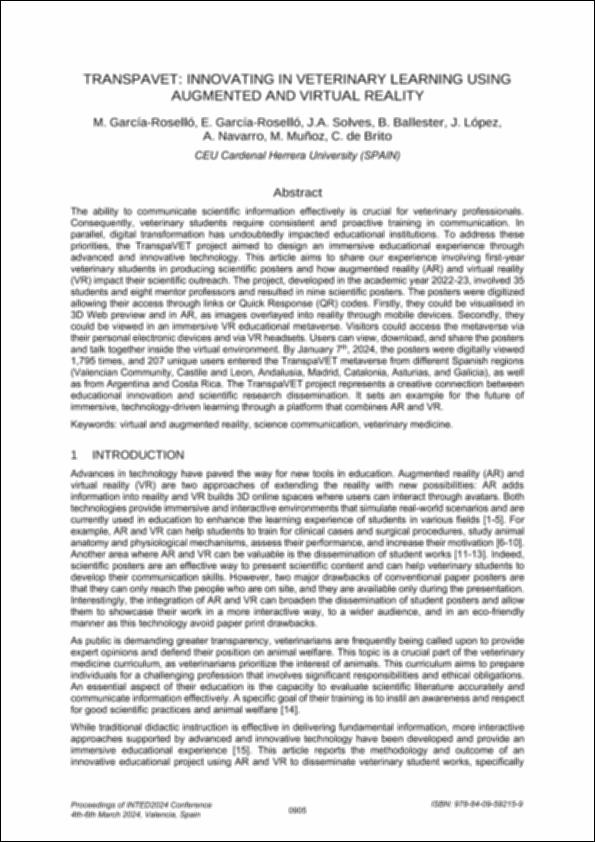Por favor, use este identificador para citar o enlazar este ítem:
http://hdl.handle.net/10637/15920TranspaVET: innovating in Veterinary learning using augmented and virtual reality
| Título : | TranspaVET: innovating in Veterinary learning using augmented and virtual reality |
| Autor : | García Roselló, Mireia García Roselló, Empar Solves Almela, Josep Antoni Ballester Lurbe, Begoña López Ramon, Jordi Navarro Serra, Ana Muñoz Baquero, Marta de Brito, Christelle |
| Materias: | Veterinaria; Veterinary medicine; Realidad virtual; Virtual reality; Realidad aumentada; Augmented reality; Comunicación científica; Scientific communication |
| Editorial : | International Academy of Technology, Education and Development (IATED) |
| Citación : | García Roselló, M., García Roselló, E., Solves, J.A., Ballester, B., López, J., Navarro, A., Muñoz, M. y de Brito, C. (2024). TranspaVET: innovating in Veterinary learning using augmented and virtual reality. In: 18th. International Technology, Education and Development Conference (INTED2024 Proceedings), 4th-6th March 2024, Valencia, Spain (pp. 905-911). Valencia (España): IATED Academy. DOI: http://dx.doi.org/10.21125/inted.2024.0303 |
| Resumen : | The ability to communicate scientific information effectively is crucial for veterinary professionals. Consequently, veterinary students require consistent and proactive training in communication. In parallel, digital transformation has undoubtedly impacted educational institutions. To address these priorities, the TranspaVET project aimed to design an immersive educational experience through advanced and innovative technology. This article aims to share our experience involving first-year veterinary students in producing scientific posters and how augmented reality (AR) and virtual reality (VR) impact their scientific outreach. The project, developed in the academic year 2022-23, involved 35 students and eight mentor professors and resulted in nine scientific posters. The posters were digitized allowing their access through links or Quick Response (QR) codes. Firstly, they could be visualised in 3D Web preview and in AR, as images overlayed into reality through mobile devices. Secondly, they could be viewed in an immersive VR educational metaverse. Visitors could access the metaverse via their personal electronic devices and via VR headsets. Users can view, download, and share the posters and talk together inside the virtual environment. By January 7th, 2024, the posters were digitally viewed 1,795 times, and 207 unique users entered the TranspaVET metaverse from different Spanish regions (Valencian Community, Castile and Leon, Andalusia, Madrid, Catalonia, Asturias, and Galicia), as well as from Argentina and Costa Rica. The TranspaVET project represents a creative connection between educational innovation and scientific research dissemination. It sets an example for the future of immersive, technology-driven learning through a platform that combines AR and VR. |
| Descripción : | Este recurso está disponible en acceso abierto con la autorización de la revista o editorial. |
| URI : | http://hdl.handle.net/10637/15920 |
| Derechos: | http://creativecommons.org/licenses/by-nc-nd/4.0/deed.es |
| ISBN : | 9788409592159 |
| ISSN : | 2340-1079 |
| Fecha de publicación : | mar-2024 |
| Centro : | Universidad Cardenal Herrera-CEU |
| Aparece en las colecciones: | Dpto. Medicina y Cirugía Animal |
Los ítems de DSpace están protegidos por copyright, con todos los derechos reservados, a menos que se indique lo contrario.


